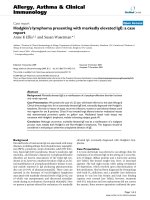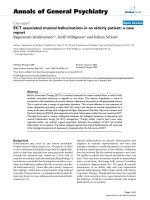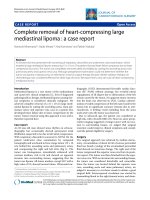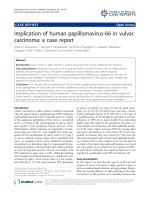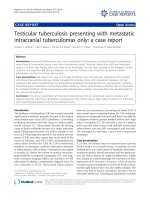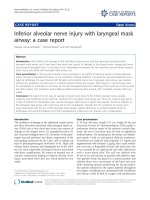Báo cáo y học: " Laparoscopic anterior gastropexy for chronic recurrent gastric volvulus: a case report" docx
Bạn đang xem bản rút gọn của tài liệu. Xem và tải ngay bản đầy đủ của tài liệu tại đây (182.39 KB, 3 trang )
BioMed Central
Page 1 of 3
(page number not for citation purposes)
Journal of Medical Case Reports
Open Access
Case report
Laparoscopic anterior gastropexy for chronic recurrent gastric
volvulus: a case report
Umberto Morelli*, Maurizio Bravetti, Paolo Ronca, Roberto Cirocchi,
Angelo De Sol, Alessandro Spizzirri, Giammario Giustozzi and
Francesco Sciannameo
Address: Università degli Studi di Perugia, Clinica Chirurgica Generale e d'Urgenza, Azienda Ospedaliera 'S Maria' Terni, Italy
Email: Umberto Morelli* - ; Maurizio Bravetti - ; Paolo Ronca - ;
Roberto Cirocchi - ; Angelo De Sol - ; Alessandro Spizzirri - ;
Giammario Giustozzi - ; Francesco Sciannameo -
* Corresponding author
Abstract
Introduction: Gastric volvulus is an uncommon clinical entity, first described by Berti in 1866. It
is a rotation of all or part of the stomach through more than 180°. This rotation can occur on the
longitudinal (organo-axial) or transverse (mesentero-axial) axis. This condition can lead to a closed-
loop obstruction or strangulation. Traditional surgical therapy for gastric volvulus is based on an
open approach. Here we report the case of a patient with chronic intermittent gastric volvulus who
underwent a successful laparoscopic treatment.
Case presentation: A 34-year-old woman presented with multiple episodes of recurrent upper
abdominal pain associated with retching and vomiting, treated unsuccessfully with intramuscular
metoclopramide. Endoscopic examination of the upper digestive tract showed a suspected rotation
of the stomach, and a chronic recurrent gastric volvulus was revealed by barium meal. The patient
was operated on successfully, with an anterior laparoscopic gastropexy performed as the first
surgical approach.
Conclusion: Experience with laparoscopic anterior gastropexy is limited only to a few described
cases. Our patient was clinically and radiologically followed-up for 2 years with no evidence of
recurrence, either radiological or symptomatic. Based on this result, laparoscopic gastropexy can
be seen and considered as an initial 'gold standard' for the treatment of gastric volvulus.
Introduction
Gastric volvulus (from the Latin volvere meaning 'to roll')
is an uncommon clinical entity, first described by Berti in
1866 [1]. It is a rotation of all or part of the stomach
through more than 180°. This rotation can occur on its
longitudinal (organo-axial) or transverse (mesentero-
axial) axis. This condition can lead to a closed-loop
obstruction or strangulation. It is seen both in children
and elderly patients, but the majority of cases are observed
in the fifth decade of life. In almost 75% of cases the vol-
vulus is secondary to other causes (para-oesophageal hia-
tus hernia, traumatic diaphragmatic hernia, eventration of
the diaphragm, abdominal bands or adhesions) [2]. It can
be classified also as sub-diaphragmatic or primary volvu-
Published: 24 July 2008
Journal of Medical Case Reports 2008, 2:244 doi:10.1186/1752-1947-2-244
Received: 7 January 2008
Accepted: 24 July 2008
This article is available from: />© 2008 Morelli et al; licensee BioMed Central Ltd.
This is an Open Access article distributed under the terms of the Creative Commons Attribution License ( />),
which permits unrestricted use, distribution, and reproduction in any medium, provided the original work is properly cited.
Journal of Medical Case Reports 2008, 2:244 />Page 2 of 3
(page number not for citation purposes)
lus, which is not associated with diaphragmatic disorders,
or supradiaphragmatic or secondary volvulus, which is
associated with diaphragmatic pathologies. Traditional
surgical therapy for gastric volvulus is based on an open
approach, but the use of a laparoscopic technique is now
advocated for multiple pathologies that once were treated
with traditional surgery.
Here we report the case of a patient with chronic intermit-
tent gastric volvulus who underwent a successful laparo-
scopic treatment.
Case presentation
A 34-year-old woman presented with multiple episodes of
recurrent upper abdominal pain associated with retching
and vomiting. All episodes were treated at home with
intramuscular metoclopramide, not requiring hospitali-
zation. Her clinical examination noted only mild tender-
ness on upper abdominal examination. Haematological
and biochemical profiling was performed, as were plain
abdominal X-ray and abdominal sonography, and all
were normal. She also underwent an endoscopic examina-
tion of the upper digestive tract, which revealed a sus-
pected stomach rotation. Following this, the patient
ingested a barium meal that showed an organo-axial rota-
tion of this organ, confirming the presence of a volvulus.
The patient was treated with nasogastric drainage, intrave-
nous fluids and proton pump inhibitors. She was offered
definitive surgical treatment for her condition by laparo-
scopic gastropexy.
Laparoscopy was performed under general endotracheal
anaesthesia. A carboperitoneum of 12 to 14 mmHg was
created through umbilical Veress needle insertion. A
number 10 trocar was placed here for camera passage. A
number 10 trocar was inserted in the right iliac fossa and
a number 5 trocar was inserted in the left iliac fossa. A
great number of peritoneal adhesions were found on
examination of the abdominal cavity. No macroscopic
diaphragmatic defect was found. A laxity of gastrocolic
and gastrophrenic ligaments was found, associated with a
medium-grade gastrectasis.
The major curve was approached by making an opening
into the gastrocolic omentum, which was divided from
the antrum to the fundus and skeletonised using an ultra-
cision harmonic scalpel. Four Ethibond 2/0 seromuscular
sutures were later placed, using the trocar ports to intro-
duce the strands. The sutures were placed on the anterior
wall of the stomach (two near the fundus on the major
and lesser curve side and two on the gastric body on the
major and lesser curve side). The needles were cut off,
retrieved and both ends of the suture were exteriorized
from the abdominal wall. The carboperitoneum was
reduced by 5 mmHg in order to progress the stomach to
the abdominal wall. The sutures were then tied into the
subcutaneous tissue through port-site incisions. Adequate
positioning of the stomach to the abdominal wall was
confirmed by visualization from within. The trocars were
removed and the wounds were closed.
The patient was allowed a fluid and light diet intake from
the first postoperative day and was discharged on the sec-
ond postoperative day. A year later she underwent a bar-
ium meal investigation which revealed no radiological
abnormalities and she remained asymptomatic at a fol-
low-up of 2 years.
Discussion
Gastric volvulus is defined as an abnormal rotation of the
stomach of more than 180° [3], creating a closed-loop
obstruction, resulting finally in incarceration and strangu-
lation. This uncommon clinical entity was first described
by Berti in 1866 [1] who described an autoptical case
observed in a 61-year-old woman, but it remains a rare
finding in common clinical practice. In 1904 Borchardt
described the classic triad of severe epigastric pain, retch-
ing with vomiting and inability to pass a nasogastric tube
[4]. Gastric volvulus can be classified into three forms,
organo-axial, mesenterico-axial and combined. In the first
form the stomach rotates around an axis that connects the
gastro-oesophageal junction and the pylorus, the antrum
rotating in the opposite direction to the fundus of the
stomach. The second form is characterized by the rotation
around an axis that bisects both the lesser and greater
curve; the rotation is usually incomplete and occurs inter-
mittently, with uncommon vascular compromise. The
combined form is rare; in this case the stomach twists
both mesenterico-axially and organo-axially. This form is
usually observed in patients with chronic volvulus. Vari-
ous ligamentous structures normally keep the stomach in
place: the gastrophrenic ligament, the gastrocolic liga-
ment, the gastrosplenic ligament and peritoneal fixation
of the duodenum. The absence or loosening of gastrocolic
and gastrosplenic ligaments were demonstrated by Dal-
gaard to cause gastric volvulus [5].
Congenital diaphragmatic hernia, para-oesophageal her-
nia or wandering spleen are the main secondary causes of
this condition [6-8]. Both chronic recurrent and acute gas-
tric volvulus have been reported. Clinical findings appear
to be related to the degree of rotation and subsequent gas-
tric obstruction. They include recurrent abdominal pain,
vomiting and gastric distension in the chronic recurrent
form, through to clinical evidence of acute abdomen due
to vascular compromising in the acute form, or as a com-
plication of the chronic recurrent form. The Borchard
triad [4] was not seen in our case as a nasogastric tube was
placed without problem. Most cases are treated routinely
Journal of Medical Case Reports 2008, 2:244 />Page 3 of 3
(page number not for citation purposes)
as gastritis, with subsequent therapy based on proton
pump inhibitors and/or antacids.
The diagnosis of chronic volvulus can be obtained with a
barium study, showing the stomach lying horizontal and
upside down, or by performing a computed tomography
scan which demonstrates two bubbles with a transition
line. A gastric volvulus requires treatment either in its
acute presentation as an abdominal emergency or when
the chronic variety becomes symptomatic, in order to pre-
vent complications [9].
In 1968 Tanner [3] described various methods of surgical
repair for gastric volvulus. These included gastrojejunos-
tomy, fundo-antral gastrogastrostomy (Opolzer's opera-
tion), partial gastrectomy, division of bands, repair of
diaphragmatic hernia, simple gastropexy, gastropexy with
division of the gastrocolic omentum (Tanner's operation)
and repair of eventration of the diaphragm. Most of these
have become obsolete, substituted by less-invasive tech-
niques. Endoscopic derotation of the stomach has given
satisfactory results [10,11]. Given the recurrent nature of
this clinical condition, endoscopic derotation can be con-
sidered as a temporary solution. In patients with high-risk
pre-operative conditions, endoscopic derotation with a
single or dual PEG (percutaneous endoscopic gastros-
tomy) tube placement has been reported to have success
[12,13]. However, some concern about this procedure
comes from reported gastric rotations initiated by PEG
tubes [14]. There have been few reports of laparoscopic
gastropexy for management of acute and chronic gastric
volvulus [9,15,16]. Laparoscopy has the advantage of
placing the stomach in a three-dimensional plane, giving
correct sight of suture placement, with no risk to the peri-
toneal wall. Our technique included some important
steps to prevent recurrence. The gastrocolic ligament divi-
sion from antrum to fundus, as described by Tanner [3],
reduced the upward pulling force and drag on the greater
curvature. The use of an ultracision harmonic scalpel ena-
bled us to achieve a precise dissection with minimal blood
loss. We secured the stomach with four sutures tied to the
abdominal wall through port incisions, and these transab-
dominal sutures provided a more secure anchorage for the
stomach, to prevent recurrences.
Conclusion
Chronic gastric volvulus is an uncommon cause of recur-
rent abdominal pain. Its diagnosis must be suspected in
patients where no real organic aetiology can be found.
Experience with laparoscopic anterior gastropexy is lim-
ited to only a few described cases. Our patient was clini-
cally and radiologically followed-up for 2 years with no
evidence of recurrence, either radiological or sympto-
matic. Several other authors have approached this disease
in a similar manner, achieving similarly good results.
Although laparoscopic gastropexy is not yet defined as the
'gold standard' for treating recurrent gastric volvulus,
these results can be viewed optimistically.
Abbreviations
PEG: percutaneous endoscopic gastrostomy.
Competing interests
The authors declare that they have no competing interests.
Authors' contributions
UM conceived of the study, collected data and drafted the
manuscript. MB, PR, RC, ADS, AS, GG and FS helped to
draft the manuscript and critically reviewed it. All authors
read and approved the final manuscript.
Consent
Written informed consent was obtained from the patient
for publication of this case report and accompanying
images. A copy of the written consent is available for
review by the Editor-in-Chief of this journal.
References
1. Berti A: Singolare attorcigliamento dell'esofago col duodeno
sequito da rapida morte. Gazz Med Ital 1866, 9:139-141.
2. Wasselle JA, Norman J: Acute gastric volvulus: pathogenesis,
diagnosis, and treatment. Am J Gastroenterol 1993, 88:1780-1784.
3. Tanner NC: Chronic and recurrent volvulus of the stomach.
Am J Surg 1968, 115:105-109.
4. Borchardt M: Aus Pathologie und terapie des magenvolvulus.
Arch Klin Chir 1904, 74:243.
5. Dalgaard JB: Volvulus of the stomach. Acta Chir Scand 1952,
103:131-136.
6. Karande TP, Oak SN, Karmarkar SJ, Kulkarni BK, Deshmukh SS: Gas-
tric volvulus in childhood. J Postgrad Med 1997, 43:46-47.
7. McIntyre RC, Bensard DD, Karrer FM: The pediatric diaphragm
in acute gastric volvulus. J Am Coll Surg 1994, 178:234-238.
8. Spector JM, Chappel J: Gastric volvulus associated with wander-
ing spleen in a child. J Pediatric Surg 2000, 35:641-642.
9. Bhandarkar DS, Shah R, Dhawan P: Laparoscopic gastropexy for
chronic intermittent gastric volvulus. Indian J Gastroenterol
2001, 20:111-112.
10. Kodali VP, Maas LC: Endoscopic reduction of acute gastric vol-
vulus. J Clin Gastroenterol 1995, 21:331-332.
11. Bhasin DK, Nagi B, Kochhar R, Singh K, Gupta NM, Mehta SK: Endo-
scopic management of chronic organoaxial volvulus of the
stomach. Am J Gastroenterol 1990, 85:1486-1488.
12. Baudet JS, Armengol-Miro JR, Medina C, Accarino AM, Vilaseca J,
Malagelada JR: Percutaneous endoscopic gastrostomy as a
treatment for chronic gastric volvulus. Endoscopy 1997,
29:147-148.
13. Eckhauser M, Ferron J: The use of dual percutaneous endo-
scopic gastristomy (DPEG) in the management of chronic
intermittent gastric volvulus.
Gastrointest Endosc 1985,
31:340-342.
14. Alawadhi A, Chou S, Soucy P: Gastric volvulus – a late complica-
tion of gastrostomy. Can J Surg 1991, 34:485-486.
15. Koger K, Stone J: Laparoscopic reduction of acute gastric vol-
vulus. Am Surg 1993, 59:325-328.
16. Siu WT, Leong HT, Li MK: Laparoscopic gastropexy for chronic
gastric volvulus. Surg Endosc 1998, 12:1356-1357.
